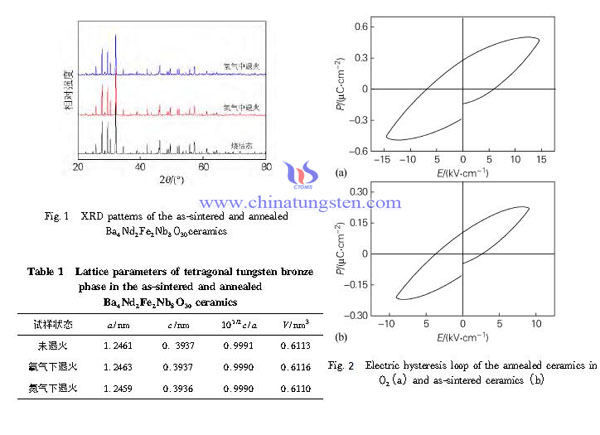Annealing Effect on Tungsten Bronze Niobate Dielectric Structure
- Details
- Category: Tungsten Information
- Published on Tuesday, 17 May 2016 18:33
The XRD pattern before and after the annealing treatment of Ba4Nd2Fe2Nb8O30 sample is shown in Figure 1. In Figure 1, all the diffraction peak position and relative intensities are exactly matching tungsten bronze phase, which means the formation of single-phase tungsten bronze and no other impurity phases. It is different from Josse’s study that he has reported the formation of barium ferrite. Lattice parameters from XRD peak calculated by the least square method is shown in Table 1.
Typically, the oxide ceramic with the presence of oxygen vacancies annealing in oxygen, the content of oxygen vacancies will reduce significantly; and annealing in nitrogen, the content of oxygen vacancies will increase significantly. Therefore, when Ba4Nd2Fe2Nb8O30 ceramics annealing under oxygen and nitrogen, the content of oxygen vacancies will be correspondingly reduce and rise. Reducing of the content of oxygen vacancies will increase the lattice constant and the unit cell volume; and increasing of the content of oxygen vacancies will reduce the lattice constant and the cell volume. So, when Ba4Nd2Fe2Nb8O30 ceramics annealing under nitrogen and oxygen respectively, the cell volume turns smaller and larger correspondingly.
Figure 2 shows the hysteresis loop at room temperature of Ba4Nd2Fe2Nb8O30 ceramics when no annealing and annealing in oxygen. As the analysis of the dielectric properties, the oxygen vacancies content of the Ba4Nd2Fe2Nb8O30 ceramic annealing in nitrogen significantly increases, the conductivity decreasing results in the group of samples can not be tested the hysteresis loop. The hysteresis loop of Ba4Nd2Fe2Nb8O30 ceramic unannealed and annealed in oxygen was observed, indicating that they all have room temperature ferroelectricity. By contrast, the ferroelectric of sample annealing in oxygen is more obvious, residual polarization is large, coercive field is large, and it’s tend to be more saturated.


| Tungsten Oxide Supplier: Chinatungsten Online www.tungsten-oxide.com | Tel.: 86 592 5129696; Fax: 86 592 5129797;Email:sales@chinatungsten.com |
| Tungsten News & Prices, 3G Version: http://3g.chinatungsten.com | Molybdenum News & Molybdenum Price: http://news.molybdenum.com.cn |